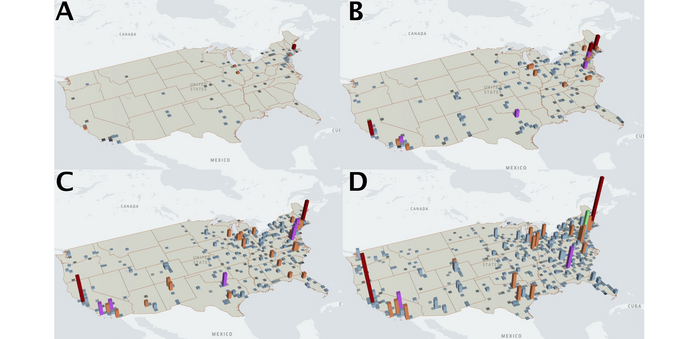If you want to open a restaurant, you first have to invest – in waiters, chefs, facilities, and equipment – to be profitable later on. “Political decision-makers and investors of a region face a similar situation. If they decide to invest in a new field of research, they have to become leaders at a certain point to be profitable,” CSH researcher Vito D. P. Servedio explains.

Credit: © Complexity Science Hub
If you want to open a restaurant, you first have to invest – in waiters, chefs, facilities, and equipment – to be profitable later on. “Political decision-makers and investors of a region face a similar situation. If they decide to invest in a new field of research, they have to become leaders at a certain point to be profitable,” CSH researcher Vito D. P. Servedio explains.
RICH GET RICHER
Therefore, they need financial resources and scientists. “Early investment in emerging areas of research is a key driver of scientific dominance,” he continues. Once the pioneer has established an area or technology, researchers are also more likely to move into this new, stimulating environment. This “get-rich-richer” phenomenon underlies the development of scientific strength in a region. And scientists’ mobility drives the development of scientific disciplines. The question is, then, how many scientists does a region need to hire so that other scientists find its environment attractive and join its institutions?
NO CRITICAL MASS
The team found no evidence for the existence of a minimum number of researchers to hire. Or in technical terms: there is no critical mass to start and carry on a new research field successfully. Here, the scientists focused on three scientific areas: semiconductors, embryonic stem cells (ESC) and internet research.
“In a way, this contradicts the generally held belief that you need a minimum number or critical mass of researchers to make a field successful. In our study, it becomes apparent that this is not the case,” Stefan Thurner from CSH states.
BE A PIONEER
In fact, regions seem to be successful when they manage to jump early on a train and become pioneers in a field. “We also find, as common sense suggests, that regions moving early into new technologies tend to dominate the corresponding scientific fields in the future,” Thurner explains.
CHINA: EXPENSIVE RACE TO CATCH UP
If a region was not a pioneer, but still wants to achieve leadership in a given area of research it has to make extraordinary efforts to catch up. “Strategic interventions must be sustained over decades to compete for a leading position in a field, as is evident, for example, in Chinese semiconductor science, where the catch up-process began in the late 1970s and has led to a dominant role today,” Servedio says.
A model specially developed by the researchers can explain the development pattern of China – how they take over specific research areas and grow the number of scientists publishing in those fields. “After all, China has some of the fastest-growing institutions worldwide. With our model, you can clearly see that China is closing the gap with the US, potentially taking on huge costs, but also showing their ability to effectively engage with high impact research. While first movers may have an advantage in some contexts, it is not necessarily impossible for late-comers to catch up or even surpass first movers in a scientific field.” CSH researcher Márcia R. Ferreira says.
THREE RESEARCH FIELDS AND MILLIONS OF DATA
With the help of the Dimensions database, the researchers at CSH could track scientists moving across regions of the world (they derived these movements from the scientists’ affiliations) in three fields – namely semiconductors, embryonic stem cells (ESC) and internet research. “In this way, we analyzed data spanning several decades with information on millions of publications, 20 million researchers and more than 98,000 research institutions worldwide,” Servedio states.
In the field of semiconductor research, they tracked 5,062,639 articles and 2,011,170 researchers in 1,633 regions worldwide between 1941 and 2019; in the field of stem cell research, they tracked 1,083,100 articles and 752,575 researchers in 1,161 regions worldwide over the same period; and in the field of internet research, they tracked 246,953 articles and 109,098 researchers in 1,032 regions worldwide between 1956 and 2019.
“What our results clearly show is if regions want to become a leader in a field, they must try to get involved early on. It is possible to catch up, but this comes at tremendous costs,” Thurner and Servedio state. “Nonetheless, our model of scientific capacity building is a simplification. There are other factors contributing to the success of a field that we have not yet been able to explore here and which will be the subject of future analysis,” Ferreira states.
About CSH
The mission of the Complexity Science Hub Vienna is to host, educate, and inspire complex systems scientists dedicated to making sense of Big Data to boost science and society. Scientists at the Hub develop methods for the scientific, quantitative, and predictive understanding of complex systems.
The CSH is a joint initiative of AIT Austrian Institute of Technology, Central European University CEU, Danube University Krems, Graz University of Technology, IIASA, Medical University of Vienna, TU Wien, VetMedUni Vienna, Vienna University of Economics and Business, and Austrian Economic Chambers (WKO). https://www.csh.ac.at
Journal
Chaos Solitons & Fractals
DOI
10.1016/j.chaos.2022.113020
Method of Research
Data/statistical analysis
Subject of Research
People
Article Title
Scale-free growth in regional scientific capacity building explains long-term scientific dominance
Article Publication Date
21-Dec-2022




